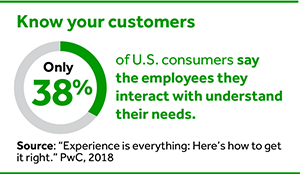Editor’s note: At DLL we’re more than a financial solutions provider–we’re your partner. Your customer is our customer and your success is our success. It’s why we’re focused on helping you grow, not just through our product offering, but also by giving you valuable insights that can help you sustain and build your business for the future. The following article is part of a series from DLL about how you can take steps to improve the customer experience your business delivers. Customer experience is part of an ongoing journey at DLL, and it’s something we’re working to improve every day. Hopefully some of the lessons we’ve learned along the way can be valuable to your business.
When you think about great customer experiences, it’s easy to focus on the “brand” delivering that experience. But in reality, brands don’t create great experiences. People do. More specifically, the employees of your company are the ones that ultimately own and deliver a great experience.
Designing a great customer experience is a worthwhile endeavor but, at the end of the day, the best thought-out plans will have no impact if your employees don’t make it a reality.
I know what you’re thinking. How do you actually help your employees do that? At DLL, we are continually listening, learning and improving the experience we deliver so I’d like to share a few of the tips we’ve learned along the way.
Tip #1: Experience starts with understanding
Creating a great customer experience comes from employees who understand and embrace the “why” behind the initiative. Be sure every employee knows your vision for customer experience and understands what (behavioral) change is being asked of them. And importantly, don’t forget to empathize. Acknowledge to your employees that certain barriers may exist to them creating a well-designed customer experience – and outline meaningful steps you are taking to help break down those barriers.
Help your employees understand the importance of delivering an excellent customer experience by asking them the right questions. As employees often have valuable insight into the minds of your customers, some of those questions might be:
- What surprises and delights our customers?
- What frustrates them?
- Are any of our processes inefficient?
- What complaints do you hear from customers?
- What do you need to deliver a better experience for customers?
- Are you clear about the impact your role has on our customer’s journey?
- What qualities do you think are must-haves to deliver a great customer experience?
- What should we be doing to create a more customer-centric culture?
- What emotions do you see most often from our customers?
Tip #2: Lead by example
Your employees may be well-versed in what makes a customer experience great. They may even fully understand the “why” behind it. But to truly drive your employees to deliver that experience, it is vital that you act as a role model. People tend to follow by example (especially from their leaders and colleagues), so why not lead and inspire by showing the effectiveness of a great customer experience for yourself?
Tip #3: Use data to tell the story
Delivering a better experience shouldn’t be subjective. Using the insights gathered from your voice of the customer research, you can share the data and insights you’re getting to drive home where the challenges and the opportunities are for the business and for your people.
Tip #4: Train with a set of principles
Great customer experiences don’t happen by accident. They are carefully designed and executed by every single person within your company.
To that point: Your employees can’t deliver a great customer experience if they don’t know how to deliver it. Develop interactive training that helps generate consistency across your business. Included within this training presentation should be a series of simple principles that everyone can adhere to in order to create a great experience. You should also include clear guidance for how your employees should interact with customers.
As an example, at DLL, we’ve created our HELP principles. Every member of DLL is expected to:
- Humanize the experience by showing empathy and enthusiasm
- Explain clearly and plainly
- Learn and be fluent in our products and services
- Personalize every interaction
Principles are important – but examples offer crystal clarity on what the business is looking for. Paint a picture for your employees of what a great experience really means and how they can deliver it in their day-to-day roles. Importantly, these principles should be rooted in real behaviors anyone can execute – for instance, you could guide your people to always thank a customer for their business and make a personal connection beyond work.




